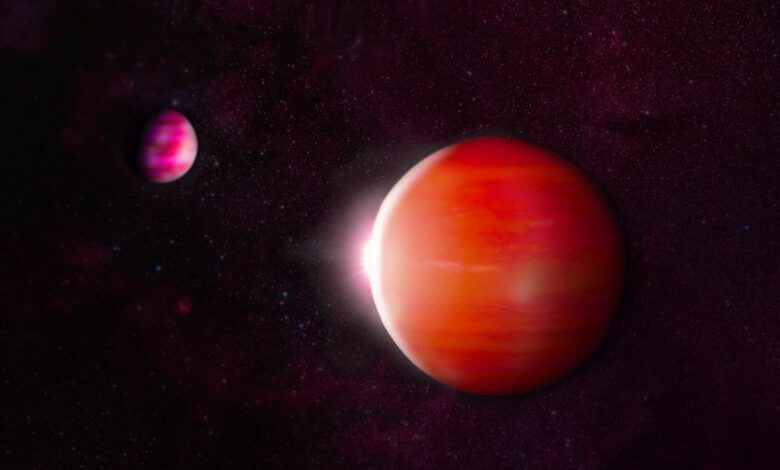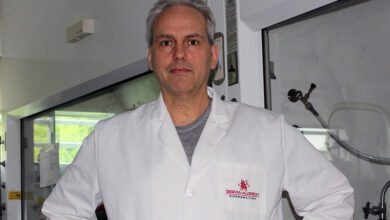
A solar neighborhood census, thanks to NASA citizen science
Concept art by citizen scientist William Pendrell shows, on the left, a cool brown dwarf called T Dwarf, and on the right, a warmer brown dwarf passing in front of a distant star. Pendrell, who is also an illustrator, is participating in Backyard Worlds: Planet 9, which uses NASA data to search for brown dwarfs and other objects. Credit: William Pendrell
× Close
Concept art by citizen scientist William Pendrell shows, on the left, a cool brown dwarf called T Dwarf, and on the right, a warmer brown dwarf passing in front of a distant star. Pendrell, who is also an illustrator, is participating in Backyard Worlds: Planet 9, which uses NASA data to search for brown dwarfs and other objects. Credit: William Pendrell
To conduct a census of nearby cosmic objects, sending a survey will not work. Scientists need to use many telescopes of different specializations to map out what is in the general vicinity of the Sun.
In an effort to understand more about our neighbors and how they came to be, scientists are collaborating with them Citizen scientists And volunteers from all over the world. They helped professional scientists conduct a new census of more than 4,000 people Cosmic objects Through Backyard Worlds: The Citizen Science Project for Planet 9.
new Stady in The Astrophysical Journal Supplement Series The results of that census appear 65 light-years from the sun. The researchers found that the number of stars is four times greater than the number of stars Brown dwarfs In this region, however, low-mass objects are more common than high-mass objects. The average body mass in this region is 40% of the mass of the Sun.
J says “There’s something about the star formation process buried in that data,” said Davey Kirkpatrick, lead author of the study and a research scientist at IPAC (Infrared Processing and Analysis Center) of the California Institute of Technology in Pasadena, California. “We have another idea about how it works.”
What are brown dwarfs?
Brown dwarfs aren’t quite stars and aren’t quite planets, but they’re somewhere in between. They are generally more massive than Jupiter, but they do not incorporate hydrogen into their cores the way even lower-mass stars do. The study supports the idea that the process of forming brown dwarfs is somewhat different from the process of forming higher-mass stars. Both types of objects are thought to form when a cloud of gas and dust collapses, but there may be different “seeds” that determine whether one type of object forms versus the other.
Citizen scientists sped up the process of identifying objects in this census by about 10 to 15 years, compared to if researchers had done the work without them, Kirkpatrick said.
How scientists helped citizens
Through Backyard Worlds, citizen scientists indicate whether objects in sets of images could be “nearby” — that is, within the general area of our Sun in the galaxy — by looking for the movement of objects relative to the background.
A small team of citizen scientists has developed a tool called WISE View, using images from NASA’s WISE (Wide-field Infrared Survey Explorer) mission to easily stitch together images into animations.
A larger group of volunteers then used that animation to find the moving objects. “They made the project more efficient for everyone,” Kirkpatrick said. (The WISE mission ended in 2011, but the spacecraft was reactivated as NEOWISE in 2013, focusing on its survey of near-Earth objects.)
Kirkpatrick also created a program called Stellar Ambassadors through which citizen scientists helped search the scientific literature on what was known about these objects before.
One complicating factor in estimating how common brown dwarfs are is that some of them are almost indistinguishable from low-mass stars. For example, an object with a mass of 75 times Jupiter’s mass could be either a brown dwarf or a faint star, and current telescopes cannot tell the difference.
The next step in this line of research is to examine data from NASA’s James Webb Space Telescope, which studies molecular clouds containing star seeds, brown dwarfs and planets. Future investigations could reveal more about how these seeds differ from each other.
Learn about the world of Muwatin
Among the citizen scientists who participated in the new study and are credited as co-authors is Léopold Grammays in Paris. When he’s not researching cosmic data, he works as director of security and operations at Paris’s Charles de Gaulle and Le Bourget airports.
Grammays encountered the Backyard Worlds project in 2019 and liked the idea of searching for brown dwarfs, which he had never heard of before. Grammayes became so interested in these things that he learned how to program so he could search astronomical databases faster. As part of this particular study, he was involved in the discovery of a few brown dwarfs and helped review the scientific literature.
“I like the fact that brown dwarfs are a little mysterious,” he said. “It’s just a few pixels, and yet it’s here.” Three citizen scientists from the Backyard Worlds Project were given time to observe Webb as co-investigators on selected Webb proposals.
more information:
J. Davie Kirkpatrick et al., Initial mass function based on a 20-block all-sky census of ∼3600 stars and brown dwarfs, The Astrophysical Journal Supplement Series (2024). doi: 10.3847/1538-4365/ad24e2
Magazine information:
Astrophysical Journal Supplement



